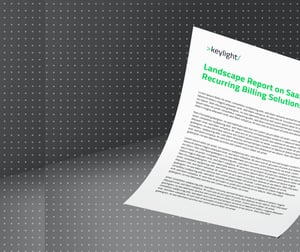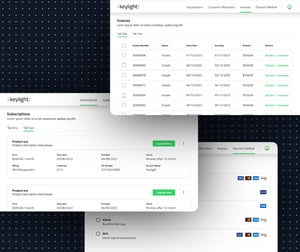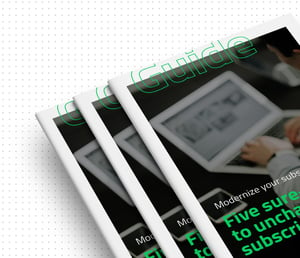Design thinking for subscription businesses | Part one
 t keylight we are focused on two things - our customers and solving their subscription business problems.
t keylight we are focused on two things - our customers and solving their subscription business problems.
To achieve both of those things we employ design thinking across the board with the ultimate goal of facilitating our clients’ long-term customer and partner relationships, and ultimately achieving business success and sustainability.
The purpose of design thinking and how it enables this process is something that we’re going to explore in our upcoming series of articles. For example, we will look at its role in creating the user experience (UX) and user interface (UI) and ultimately how a great user experience can increase conversion rates for your business.
In this article, we wanted to establish what design thinking is for keylight and how it changes the game for businesses by pivoting away from a traditional way of solving complex development challenges in subscription models.
What is design thinking?
Design thinking is a term that’s popular in software development right now. It’s a non-linear, iterative approach that encourages people to look at problems from a different perspective, challenging assumptions, going to the root of the issue and exploring the possibilities for better outcomes.
Often conflated with UX and UI, which are part of it, it’s a larger umbrella for design and conceptualisation. Crucially, it isn’t just about the end goal of finding a fixed solution; it’s a process of learning and evolution, focused on understanding and conceptualising the problem.
Adam Bałazy, Senior UX/UI Designer at Ideamotive said:
“Its main objective is to create innovative, custom solutions for well-defined problems.”
How can design thinking enable your business success?
Design thinking is all about identifying, understanding and addressing challenges faced by businesses and their customers.
Launching a subscription business model is a commitment to a long-term project. That goal is only possible with systems and processes that can adapt and evolve over time as the competitive landscape and user requirements change.
The focus that design thinking places on ongoing learning and understanding is ultimately where its benefits lie for subscription businesses, for two reasons:
- It encourages a mindset where subscriptions are about building strong customer relationships over time, and looking into customer problems through constant innovation, exploration and experimentation.
- The net result is that the data collected from the processes above enhances our knowledge of user needs and leads to ever better user experiences.
If design-thinking is not incorporated into subscription businesses when building the architecture of the ecosystem, user requirements can't be fulfilled and ultimately the business will not be able to develop alongside the shift of the market and customer needs.
How does keylight apply design thinking?
At keylight, we solve the fundamental challenges that businesses encounter with a user-centric approach, applying the five core stages of design thinking:
1) Empathize with the user
Empathize with the wants and needs of the user (prospect, customer, partner, sales, finance and development teams). With extensive knowledge and experience in subscriptions from providing professional services to subscription businesses, we talk to system users across industries and analyze how they interact with regular billing systems.
2) Define the problem
Design thinking is roughly interpreted as ‘thinking outside the box’. In essence, it’s about being open-minded about the challenge rather than making assumptions about it. We realized that many systems are not designed to work with others and businesses spend a lot of time connecting them. How the users interact with the systems to get things done is not considered until the technical setup is ready to go. This is what causes the long wait time to go to market, and poor usability in finance-centric systems.
3) Take a user-centric approach to design
Take a humanistic (user-centric) approach to focus on the root cause of the issue. To take meaningful actions rather than delivering superficial solutions, before modelling capabilities on the keylight platform, we start by asking ‘what would the user need to perform this action?’ rather than ‘how can we automate and sync this action with the other systems?’.
4) Create the prototype
Create the prototype and be prepared (excited even!) about the likelihood of making changes and refinements following the next stage of testing. It can also be described as adopting a ‘beginner’s mind’ in the design process - one that’s open to discovery and with a fresh, unbiased perspective. Adopting a user-centric approach allows us to look at business processes across departments and create an end-to-end solution from the beginning of a subscription businesses' journey. For almost all business processes, different users and teams are involved and need to collaborate and communicate data to make things work.
5) Test the prototype
Test the prototype with a view to being open to the different possible outcomes, allowing the results to further define the problem. Our mathematicians tested our software prototype repeatedly and reiterated the logic of our data models until we could cover the most complex subscription cases, straight out-of-the-box, while still remaining flexible for businesses to customize and scale.
This makes us unique from any other subscription platforms and legacy systems, which tend to be led by a finance-driven approach to design. Ultimately that’s where most problems begin.
It’s essential for subscription businesses to have technologies that can enable possibilities beyond preconceived ideas. We create our software solutions by looking at the root cause of the issues that subscription businesses face as they grow so that our customers can focus on building relationships and recurring revenue.

Employ design thinking with a
user-centric subscription system
Start now with >keylight/




